The Brazos Performance Preview: AMD E-350 Benchmarked
by Anand Lal Shimpi on November 16, 2010 12:01 AM ESTMobile IGP Comparison
I narrowed down the platforms for our mobile IGP comparison. I simulated a Core i3 350M by taking an i3-530, underclocking it (I couldn't do anything about the 4MB vs. 3MB L3 cache) and capping its GPU frequency at 667MHz. This is the best case scenario for the i3-350M, and as you'll see below, it doesn't really matter. I also paired a 2.2GHz Pentium Dual-Core with a G45 motherboard, agian simulating the cheaper mobile Pentium platform. Finally I installed Windows 7 on the 1.6GHz Core 2 Duo based 11-inch MacBook Air with its GeForce 320M to give you an idea of the upper bound for mobile performance with what might as well be a low end discrete GPU.
Updated: I've added performance results from a simulated Core i3-330UM, the E-350's competition in ultra portables.
We'll start with Modern Warfare 2:
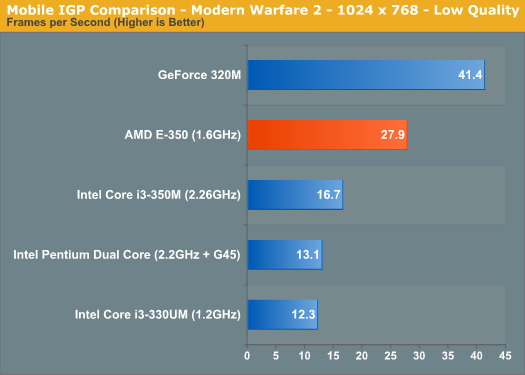
The E-350 puts the i3-350M, i3-330UM and Pentium DC to shame, delivering 67% better performance. The frame rate is just shy of being totally smooth however. I found that in most modern games 1024 x 768 would result in frame rates just under 30 fps.
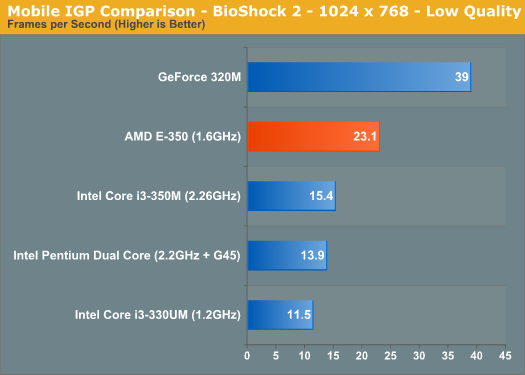
BioShock 2 showed a similar performance advantage. Again we're not able to break 30 fps but the performance advantage is huge compared to the Intel platforms with integrated graphics.
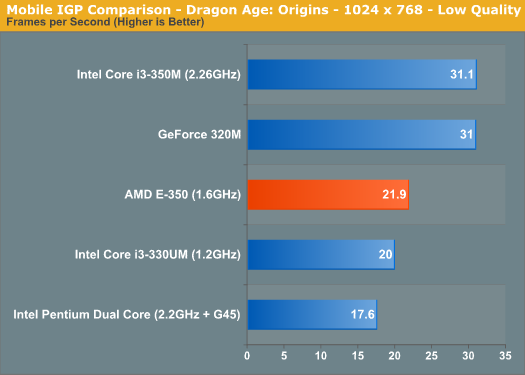
Dragon Age: Origins is mostly CPU bound at low quality settings and thus there's no real advantage to the E-350's Radeon HD 6310 GPU. It's faster than the Pentium/G45 platform, but significantly slower than the i3-350M. I expect most games however to be GPU bound at these settings across the board.
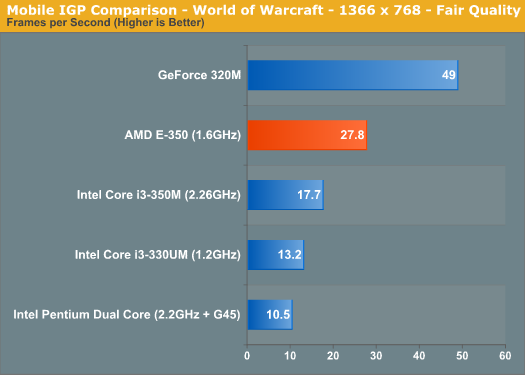
World of Warcraft continued the trend. The E-350 ended up 57% faster than the i3-350M, although still fell short of a discrete GPU.
Of course I wondered how well Brazos would play Starcraft 2:
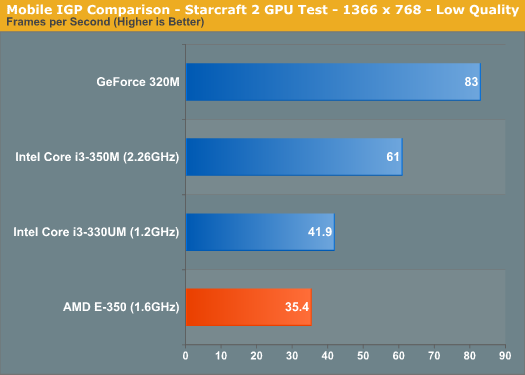
The GPU handles SC2 just fine, however the game is very CPU dependent and thus you see a pretty big advantage from the mainstream i3 system. The comparison is a lot closer when we look at the i3-330UM. The E-350 won't be able to play SC2 as well as a $500 mainstream notebook, but it'll be comparable to an ultraportable running ULV Arrandale.
We don't have numbers for the G45 platform here because the system wouldn't run our benchmark (our tests use an older version of SC2 which apparently had issues with the G45 drivers).
Our SC2 CPU test gives you an idea of the lower end of performance in large multiplayer battles:

The E-350 offers only 58% of the performance of the i3-350M system. The Bobcat cores do hold the platform back from time to time. Again, compared to the i3-330UM there's no performance difference at all.
Just for kicks I also ran the Civilization V benchmark, which gave us two datapoints: GPU performance and no-render/CPU performance.
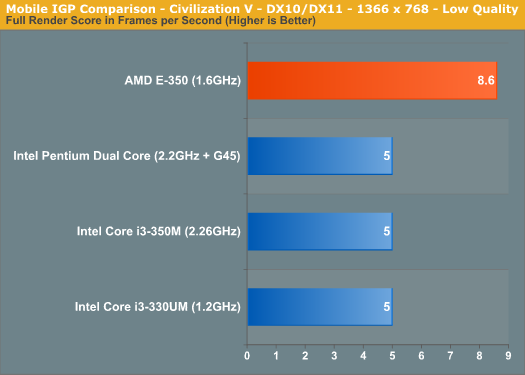
The benchmark doesn't score well on either platform, although AMD does hold a 72% performance advantage over the i3 and G45 platforms. The CPU test puts the E-350 at about 55% of the speed of the Pentium dual core platform.
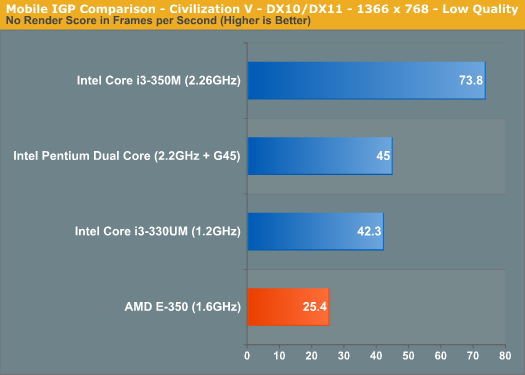
Civ V is one area where the Arrandale CPU advantage wins out over GPU performance.
Overall, the E-350 has no problems outperforming any of the current Intel integrated graphics offerings in 3D games. In CPU bound titles the E-350 loses out to the mainstream i3, but is competitive with ultra low voltage i3s. Just as with Atom, you'll have to sacrifice performance vs. a mainstream notebook, but compared to low voltage Arrandale the E-350 can hold its own.










207 Comments
View All Comments
jdonkey123 - Tuesday, November 16, 2010 - link
What are the primary processor-related factors for consumers buying a new mobile PC?Battery Life, Price, Form Factor, & Performance (perceived)
When you look at these factors, it's pretty obvious that this platform fits into a large hole between high-end Atom based offerings and Intel's myriad ULV and non-ULV mobile parts.
While much of that is obvious from this excellent benchmarks article, what's missing a bit is a compilation of relative power consumption (and by extension, battery life.)
The most power-hungry Atom system that this is likely to compete against in mobile can be found in the Asus Eee PC 1015PN with a DC Atom N550 + NG-ion. CNet found load power of that system to be 20.66 watts. Compare that to the E-350's 25 watts that you found under similar load (assuming gaming wasn't CNet's test case.)
In that case, the power consumption is only modestly higher for what seems like at least an equivalent boost in performance and at $429 list, AMD's system looks pretty good!
I guess I see an upgraded slate of netbooks as the most likely home for this APU and I think that as long as the pricing is there, AMD is actually in a great position to displace a ton of the higher-end Atom parts.
Ref: http://reviews.cnet.com/laptops/asus-eee-pc-1015pn...
Joe Supersales - Tuesday, November 16, 2010 - link
If you want to test one please contact Joe Jao at www.jetwaycomputer.com, Tel: 510-857-0130 Ext# 128, thanks.gudodayn - Tuesday, November 16, 2010 - link
With all the noises Intel and AMD makes, I am surprised at the little guy's performance figures, the VIA Nano DC.I read the VIA Nano DC review and knew it took out Intel Atom D510 with ease but in the larger picture with desktop CPU numbers, I didn't expect it to do what it did!!!
I am excited about consumer products developed for the VIA Nano DC but unfortunately past experiences tell us all that in the market today, its all gobbled up by other bigger players!!!
Iketh - Wednesday, November 17, 2010 - link
you're forgetting Nano's power consumption...this is everyone's argument proven in many of these posts, the article was written in the wrong light for Brazos... people looking at $500 notebooks either want near-desktop performance and dont care about 6 hour battery life, or they need a spreadsheet/web surfer with 6+ hours of battery... these are NOT competing markets
this is one instance where sticking to the price bracket does not work
sprockkets - Tuesday, November 16, 2010 - link
What about the performace of this vs. the current Zotac Ion board with the Intel SU3200 dual core chip at 1.2ghz?Dark_Archonis - Tuesday, November 16, 2010 - link
Irrelevant comparison. Intel's "i" processors offer strong performance for those who want it. For those who can't afford the performance, lower CPUs are "good enough".I'd love to hear why you think AMD settled for "good enough" in terms of Bobcat performance.
Atom will get smaller and less power hungry than Bobcat. i3 and above CPUs offer easily better performance than Bobcat. A Celeron E in many cases offer better-than-Bobcat CPU performance. Bobcat's GPU is not good enough for gaming or intensive multimedia tasks.
Bobcat ends up being stuck in no-mans land.
Clearly this discussion is about Bobcat. So tell me, what is the point of Bobcat compared to Atom? Sure it's faster than Atom, but it's still not fast enough to make a big impact in the market.
Dark_Archonis - Tuesday, November 16, 2010 - link
Yes they have a long way to go, but Intel's upcoming Atom SoC designs dramatically reduce power consumption. Cedar Trail and Oak Trail are supposed to be very power efficient Atom platforms.So Zacate is mainly good for GPU-accelerated browsing? What about when Intel offers a strong-enough GPU integrated with Atom for hardware accelerated browsing? What then?
Dark_Archonis - Tuesday, November 16, 2010 - link
Better get your wings ready then. Cedar Trail and Oak Trail will offer far lower Atom platform power consumption than current Atom platforms. Don't believe me? You'll see when the products are released, don't take my word for it.Really, "at the same price"? For the price that Zacate will go for, I'm pretty sure I would be able to get a Celeron E or Core 2 Duo-based Pentium for about the same price. Yes in some games they would perform worse due to the IGP in those products, but gaming on Zacate is a struggle anyways so it would be a moot point.
As for average everyday tasks, a Celeron E or Pentium would generally perform better than Bobcat.
You get what you pay for. Lower end products have lower end performance. This is a simple fact, no need to get politically correct.
Anyone who wants performance wouldn't be looking at this market anyways. Neither Atom nor Bobcat provide enough performance for enthusiast/performance users.
Dark_Archonis - Tuesday, November 16, 2010 - link
No, I don't "speculate much", do you?Do you want me to post links to what Intel has said about the future of Atom, or should I let you look it up yourself?
Intel itself has talked about how Atom will get smaller and lower in power consumption while keeping the same performance or better.
Iketh - Wednesday, November 17, 2010 - link
"dark_archonis", just stop... you're making a complete fool of yourselfanand need's DT's post rating scheme please